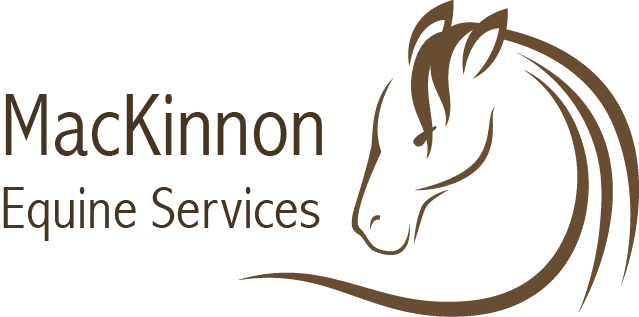Equine Dentistry - Why Treatment?
The lives of three quarters of a billion people around the world depend on horses, mules and donkeys. Of 122 million Equidae in the world 100 million are working horses, mules, and donkeys. The future of horse and man are inextricably linked therefore developing a proper maintenance program is important to this horse and man relationship. How does equine dental fit into this regular maintenance program or does it?
Dental problems DO affect the disposition in horses! Remember the last time you had a tooth ache and had to identify which tooth was giving you problems to your dentist? Identifying dental problems in a horse is no easy task and nearly impossible for the novice. It takes a lot of training and experience to ascertain the most difficult dental problems in the horse.

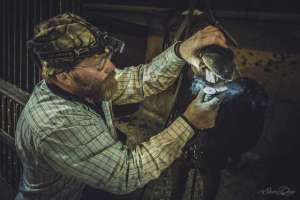
Over the years I’ve found that the average horse needs annual dental maintenance. A fat horse can also have bad teeth, condition is not necessarily an indicator of dental problems or pain. When considering the condition of your horses mouth it is important first to define the desired equine performance then balance and maintain the mouth accordingly. I have also found remarkable changes in conditioning of an animal when afforded consistent dental maintenance. In most cases a regular dental maintenance program finds better conditioning that provides less effort and less feed, most often the price of the dental work is less than the savings in feed in a years time.
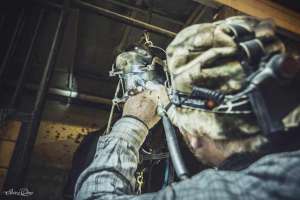
In years past, little interest has been taken in the condition of equine dental for it is out of sight, therefore out of mind. However, poor dental conditioning can cause an enormous amount of pain. Therefore, pain is reflected in poor temperament; poor temperament is reflected in unhappy horse owners and unhappy horse owners misunderstand and sometimes mistreat unhappy horses and so it goes.
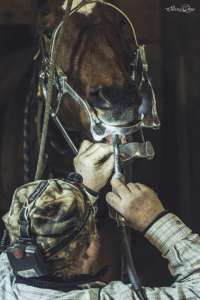
One of the first things I think we should remember about horses is that they all have different temperaments and are sensitive to different degrees of stress and pain. Horses come in a variety of sizes with no two being exactly alike. Therefore it stands to reason that all mouths are different, even though the function of each mouth is the same. Horses tend to react generally in the same manner. Horses would rather run than face a painful situation. A horse moves away from pain. It is the tendency of the horse, when feeling pain in his mouth to move ahead. He learns to slow down or stop to get relief. In effect he is backing away from pain.
What happens to the running horse experiencing pain in his mouth? They usually slow down. Therefore it stands to reason that if we remove the irritation or pain from the race horses mouth we can increase the speed of the horse. All running horses under tack use their mouth for balance and the jockey uses the irons and reins, for balance. To maintain this balance for any length of time the horse has to have a comfortable mouth. To achieve this we have to remove all obstacles of pain and irritation.
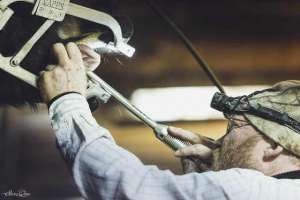
There are three basic ways we can remove the irritation or pain from a horses mouth. First, provide the horse with comfortable tack (ie. head stall, cavesons, nose bands); second, allow for comfortable bitting procedures (including styles, shapes and sizes of bits); and finally create a comfortable mouth (cheeks, teeth, gums, bars and tongue free from pain). A horse with a properly maintained mouth, proper tack and a correct bit will be able to function at his best.
The other day a prominent horse owner called and asked if I would check the teeth on a two year old filly he was racing. Her trainer said she was stopping when the jockey would take hold of her or try to maneuver her into a better position during the race. After examining the two year old, I found a number of areas of pain in her mouth. She had retained many caps (in the human mouth, caps would be considered baby teeth) that were preventing her adult teeth from erupting normally. I pulled three deciduous incisors and three caps from the pre-molars (back teeth). The caps had very sharp buccal (cheek) edges. All of the outer edges of the remaining upper arcades (rows) and inner edges of the lower arcades were also very sharp. I recommended no racing for the filly for a couple of weeks. This would give her time to find out her mouth would no longer cause her pain. Approximately two weeks later the trainer entered her at a nearby track. The filly won breaking her maiden (winning her first race) that paid $98 on a $2 ticket. Her next two outings went very well, she put forth a fine effort both times and ran two second place finishes back to back.
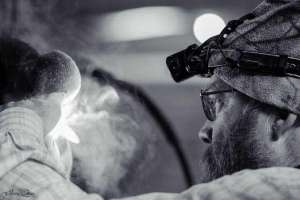
A horse may have from one to ten wolf teeth. The upper wolf teeth set just ahead of the first upper molars, so when using gags, snaffles, or over check bits they can be particularly bothersome. These bits pull the cheeks directly up into the wolf teeth. Upper wolf teeth definitely need to be removed any time the horse is being used with an over check, gag or bit that rides high or works off the roof of the mouth. Lower wolf teeth are directly in the path of the main bit and can lacerate the tongue and cheek extensively. Lower wolf teeth are also considerably more rare than upper wolf teeth. At times problems created by wolf teeth are over rated, while at other times they are at the root of the bitting problem. I elevate and remove all wolf teeth, just to avoid a chance of a later problem. The tooth needs to erupt to the point where there is enough to be pulled with forceps. Sometimes this eruption process can take from six months to a year and other times the wolf teeth may not come down but ossify to the bone.
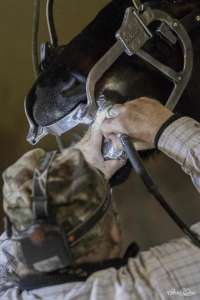
The front hooks on the upper molars come about when the leading edge of the upper molars are forward of and misaligned with the lower molars. The front edges do not wear and develop sharp points, interfering with comfortable bitting. Many times, as the bit is exerting pressure on the cheek and tongue, they are forced into these upper points causing severe pain. (I’ve removed front hooks that were over one inch in length, they had worked through the flesh, over the bars and into the jawbone.) Once hooks are removed, most horses begin to perform well. The outer edges of the molars in the upper arcades need to be well rounded to eliminate the chance of pain or injury to the cheeks caused by pressure from the bit, rings or caveson and nose band.
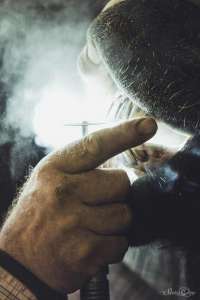
One very important thing to remember about the anatomy of the mouth is that the upper molars are set wider and to the outside of the lower molars. This means the snaffle bit is carried just below the upper molars; the bit wraps the mouth and the large rings can create pressure on the cheeks, which in turn can be irritated by sharp teeth. Further, the teeth can be irritated during the cap shedding periods (between 2 ½ to 4 ½ years of age). When caps are loosening they become very sensitive to pressure. The animal will often back off feed and not thoroughly masticate or grind their feed, due to the soreness caused by the loose tooth. At times colic and intestinal blockages are caused from poorly masticated food. Poor performance or even a debilitating condition from lack of proper nutrient utilization can occur.
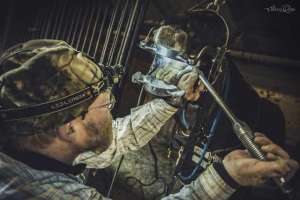
Some horses have pouchy cheeks and loose flesh over the bars that is very tender and sensitive when it comes in contact with sharp teeth or harsh bits. It is very difficult for these horses, or any horse for that matter, to keep its mind on its work when in pain. A milder bit and a proper floating job can often make the difference between an excellent or poor performance. From time to time I have found horses with a roll of skin on the bars of their mouth, just ahead of the lower molars. When the rider exerts backward pressure on the bit, this fold or roll is forced upwards between the teeth; a very painful state of affairs for the horse. Horses with this problem are hard to deal with due to the severe pain they are experiencing. A Sure-Win headstall can elevate the bit in the mouth and a smaller mouth piece will help keep the bit off the pouchy skin on the bars.
Proper equipment, bitting and dental care often can make the difference between winners and losers. Remember, all mouths are different; different sizes, sensitivity and shapes and that all horses are cutting teeth for the first five years of their lives; their mouths are continually changing.
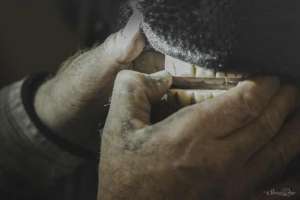 Sharp bits, poor shoeing and ill-fitting equipment along with a painful mouth can cause pain. It is difficult to find optimum performance from a horse if you can’t get him into a comfortable state of mind. And in some cases, the fear of anticipated pain will remain long after the painful areas are fixed.
Sharp bits, poor shoeing and ill-fitting equipment along with a painful mouth can cause pain. It is difficult to find optimum performance from a horse if you can’t get him into a comfortable state of mind. And in some cases, the fear of anticipated pain will remain long after the painful areas are fixed.
So get rid of the pain early.
